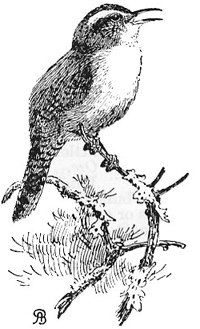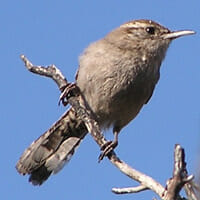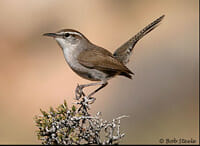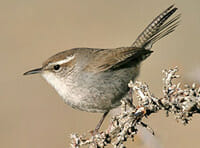Bewick’s Wren – Passeriformes Troglodytidae Thryomanes bewickii
 |
 |
 |
 |
Identification & Description:
• Small gray and brown songbird.
• Long, thin, slightly decurved bill
• Bold white supercilium
• Gray-brown upperparts
• Grayish-white underparts
• Wings and tail barred with black
• Long tail has white corners and is frequently held upright
• Dark legs
• Sexes similar
• Moderately long tail often held cocked over back.
• Thin pointed bill.
• Long white stripe over eye.
• Size: 13 cm (5 in)
• Weight: 8-12 g (0.28-0.42 ounces)
Similar species:
The Bewick’s Wren can be distinguished from House and Rock Wrens by its bold white supercilium. Carolina Wren is rustier above and buffier below. Marsh Wren has a streaked back.
Life History Groupings
• Migration Status: Short distance migrant
• Breeding Habitat: Successional-scrub
• Nest Location: Ground-low nesting
• Nest Type: Cavity
• Clutch Size: 4-11
• Length of Incubation: 12-14 days
• Days to Fledge: 14
• Number of Broods: >1?
• Diet: Primarily: Insects
Facts
• The severe declines of Bewick’s Wren in the eastern United States coincided with range expansion in the House Wren. It is suspected that the House Wren, which frequently removes eggs from nests in cavities, was directly responsible for the decline. The increased availability of nest boxes may have helped the spread of the House Wren, and therefore the decline of the Bewick’s Wren.
• The male Bewick’s Wren learns its song while still on the parents’ territory. It learns the song not from its father, but rather from the neighboring territorial males. The song repertoire developed before the first winter is retained for life.
Other Names
Troglodyte de Bewick (French)
Chivirín cola obscura (Spanish)